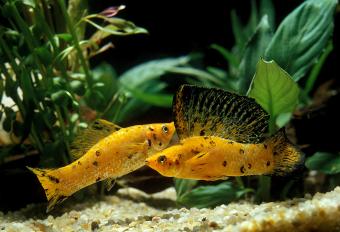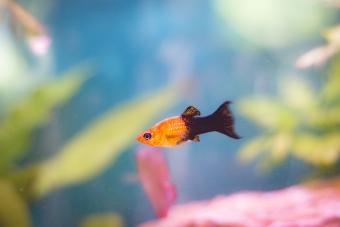
Betta fish are known for their incredible beauty and warrior-like personality, but there are certain facts about bettas that make them fascinating pets. Delve deeper into this fish's world and learn a few of their secrets with these surprising betta fish facts.
Fact One: Bettas can Breathe Above and Below the Water
Unlike most fish that only breathe by collecting oxygen from the water through their gills, the betta can breathe both below the water's surface and at the surface. Bettas have an organ called a labyrinth located just behind their heads that allows them to breathe air. They can rise to the water's surface and take a gulp of air and then swim back down as they please.
In the wild, bettas live in very slow-moving waters with less-than-ideal amounts of oxygen. The labyrinth evolved to help these fish collect enough oxygen to survive. Of course, bettas still need to live in the water even if they can breathe regular air.
Fact Two: Bettas Need Protein
Bettas will pick at almost anything you feed them, but they need to primarily eat protein. You can keep a pet healthy on a main diet of betta pellets, but your fish will also appreciate the occasional meal of live or frozen brine shrimp and freeze-dried bloodworms. Feed your pet daily, but no more than three pellets at a time. Be sure to remove any remaining food in the tank after five minutes. Bettas are prone to constipation, so some hobbyists recommend that you let your betta fast one day a week.
Fact Three: Male Bettas Are Highly Territorial
When you visit an aquarium shop, you'll notice that bettas are usually displayed in small, individual containers. If you see one in a community tank, it's most likely the only one of its species. That's because bettas are highly territorial toward one another, and they will fight to the death to defend their territory, if necessary. Bettas don't appear to be quite as territorial toward other species, but they will still nip their tank mates occasionally.
Fact Four: Females Offer More Bluster than Bite
Females are territorial, but not quite so fiercely aggressive as males. For this reason, you can keep female bettas together in what is referred to by hobbyists as a sorority tank. It's recommended that the group is no smaller than five females, and the tank must provide at least a minimum of one gallon of water per fish. It's best to introduce the females at the same time.
You can expect these fish to have a number of spats over the first 24 to 48 hours until they determine their individual territory, but then they tend to settle down. Any fins damaged during these skirmishes typically heal in a few weeks. Make sure the tank has plenty of plants to provide the female fish with places to have a quiet retreat.

Fact Five: Bettas Have an Unusual Courtship
Bettas are egg-layers as opposed to giving live birth. It's amazing to watch the courtship that goes on between a male and a female prior to fertilization. Love actually looks more like a battle, at least in the beginning, since males and females will fight with each other when forced to share the same territory.
When the male is allowed to see a female that sparks his fancy, he'll build a nest at the water's surface that is made out of mucus-coated air bubbles. When the female is introduced into his tank, he'll flare up at her and chase her around a bit. She will also flare her gills and fins as she attempts to hold him off. The male will then show his best side view to try to impress the female as he shimmies and flares his fins. When the female is ready to accept him, she'll hold quite still as he approaches and rolls her over. His body drapes over hers like a horseshoe, so their vents are close together, and he will fertilize her eggs as she releases them.
Fact Six: Meet Mr. Mom
In a rare role reversal sometimes found in nature, it's the male betta that acts as guardian of the nursery. He'll drive the female away after breeding, so she must be removed to a separate tank. He then collects each egg and secures it in his bubblenest. When the fry hatch, he'll guard them and carry them back to the nest in his mouth when they fall out and can't make their way back on their own. Once the fry are free swimming, it's time to transfer the male to a separate tank, or he will begin eating his own offspring.
Fact Seven: Bettas Jump!
Whichever type of tank you decide to use, be sure it has a secure lid. Bettas can and sometimes do jump right out of the water, which is not always a happy ending when you find them. If your betta escapes their tank, put them back in as soon as you can. Give them time to rehydrate. If you act quickly, your betta may be able to survive, as they can usually live even after being out of water for up to 10 minutes. The best way to prevent this, however, is with an adequate lid.
Fact Eight: Bettas Are as Varied as Snowflakes
Hobby betta breeders have selectively bred various mutations of betta splendens to create an incredible array of bettas in different colors, patterns, and fin types. Some bettas have spots like a Dalmatian, while others have a marbled pattern on their body and fins. Some even have dragon-like scales that are overlaid with white, copper, or even platinum. Bettas exist with crowntails, half-moon tails, and sometimes double tails. There's just no telling what kind of fascinating creature might turn up in the next batch of fry.

Fact Nine: Betta "Types" May Just Be Colors
When you buy a betta in a pet store, you may see some with fancy names such as Bumblebee, Rosetail, or Koi. These fish may be marketed as different types of betta fish, but in fact they are simply color variations that can be found in many varieties.
That's not to say that they're not unique or intriguing. Bumblebee bettas, in particular, are a very popular choice. These stunning fish typically feature a black body and lacey yellow fins. Another sought after pattern is the Dragon Scale betta, which is actually a reference to their thick, white dragon-like scales and, again, not a different species of betta. If you decide to get one of these special Bumblebees or Dragon Scales, it's important to know that they are still bettas and have the same betta temperament and needs.
Fact Ten: Bettas Were Named By a Danish Doctor
Bettas were given their name by Dr. Theodore Cantor, who received some fish from the King of Siam in 1840. Dr. Cantor began to breed the fish and gave them the scientific name Macropodus pugnax (as in "pugnacious," for their aggressive nature). However, he learned that this name was already taken by a different breed of fish. He then changed the name to Betta splendens, which means "beautiful warrior" after a warrior tribe in ancient Asia known as the Bettah. In Thailand, they are known as plakat (biting fish in Thai).
Fact Eleven: There Are at Least 14 Types of Betta Tails
Some of the most common types of betta tails are the veiltail, combtail, crowntail, delta, super delta, double tail, half moon, over half moon, half-sun, plakat, rosetail, feathertail, round tail, spadetail, and dumbo ear. The most common tail type seen in pet stores is the veil tail betta, whereas some of the other types, such as the combtail or half-sun, are incredibly rare and may be difficult to find. Some tail appearances are actually caused by genetic mutations, so these fish can be difficult to breed and are often at higher risk for certain diseases. It's also important to note that some of these are not really distinct species, but instead color and size variations.
Fact Twelve: Betta Tank Affects Lifespan
Bettas kept in small bowls will have a shorter lifespan compared to bettas kept in filtered tanks. While there is a large variety of small, unfiltered, and unheated tanks sold in pet stores that have lovely colors and designs, these are actually an unhealthy habitat for the fish. The recommend size tank is at least 2-1/2 gallons, although 5-gallon or larger tanks are preferred.
Fact Thirteen: Bettas Can be Trained
Many betta lovers and animal trainers enjoy teaching bettas to do tricks, such as jumping out of the water to touch your finger or get food, swimming through a hoop in their tank, and targeting your finger or a stick. Bettas are trained using food or using a pen light combined with food, just like dogs that are clicker-trained. The light simply replaces the clicker.
Fact Fourteen: Bettas Enjoy Resting Spots
Bettas, like most fish, sleep every day. Bettas also like resting on the bottom of their tanks or at the top of the water line. Sometimes, owners may see them floating peacefully at the top of the tank and believe they are dead, but a healthy betta in this position is just resting. A favorite resting spot of bettas is on leaves, plants, rocks, or even ornaments placed in the tank. If you adhere an artificial leaf with a suction cup near the top of the tank, you will likely see your betta resting there often.
The Ultimate Fact: Life Is Just Too Short
If you take good care of your betta and make sure they have high-quality food, clean water, and an appropriate medication if they ever look sick, they'll live about 2 to 3 years on average. Under optimum conditions, they could live as long as 5 years. Sadly, that time goes all too quickly, so appreciate your betta and enjoy them while you can.







